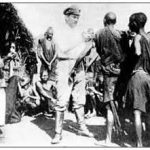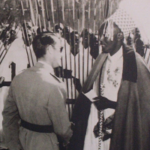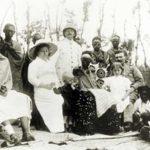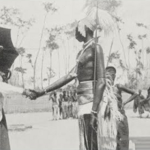State And Society Under RWABUGIRI
By the time of the European arrival at the end of the nineteenth century, Rwanda had grown, over a period of three centuries, from a small polity into a sizable state. In the past, the territory controlled by the kingdom had fluctuated as a result of succession struggles, conquest by enemy powers and, at times, successful annexation of new areas. But from the eighteenth century Rwanda experienced a steady expansion in both territorial scope and royal power. Some key elements that served to enhance the king’s status and reinforce his power included the development of centralized military organization, the elaboration of a royal ideology glorifying the king and attributing strong ritual powers to him, and the growth of a complex hierarchy of political authorities with overlapping and competing jurisdictions.
The growth of royal power did not, however, occur simultaneously in all regions. During the nineteenth century, transformations generated by increased central government penetration were concentrated in the Rwandan heartland (Nduga and nearby areas); in many areas of what is today Rwanda, local forms of political organization retained their vitality. Kinyaga was one such region, where geographical separation from the central court inhibited extensive central government involvement until the reign of Umwami Kigeri Rwabugiri (1860-1895). Subsequently, two key developments altered the political landscape of Kinyaga: the growth of intensified linkages with the royal court, and the imposition of European colonial rule. These forces brought important changes to the region, but the changes were, of course, conditioned by what had come before.
Until Rwabugiri took the throne the central Rwandan govemment placed few demands on people in Kinyaga, and Kinyagan participation in central affairs was correspondingly limited. Some Rwandan immigrants to Kinyaga preserved previous links to a central Rwandan umuheto chief. And during the reigns of Rwabugiri’s two predecessors umuheto chiefs living in central Rwanda established ties with certain prominent lineages in Kinyaga. But the majority of Kinyagans experienced little or no contact with representives of central government.
At that time Kinyaga was a geographical area, not a political entity; diversity of origins and topographical divisions contributed to heterogeneity in a population lacking any overall unity. With the exception of Bukunzi and Busoozo political authority within the region rarely encompassed units larger than the individual lineage or localized neighborhood group. Where such broader authority existed, it involved mainly the predominance of one older lineage over individuals or groups on the same or neighboring hills. A good example of this in Impara was the Abadegede lineage, composed of the descendants of Rwanteri. But there was no hierarchical political authority incorporating all or a substantial portion of the region. The administrative structures introduced under Rwabugiri therefore represented a substantial break with the past.
The separate status of Bukunzi and Busoozo reflected Kinyagan autonomy in extreme form. Relative to the rest of Kinyaga the political organization of these small kingdoms was distinct: Organized along hierarchical lines, each was headed by a king (umwami) who presided over a small group of political and ritual officials. He was viewed as the ultimate owner of land in each kingdom, and inhabitants gave him tribute (collected from lineages) in the form of food products, beer, hoes, or cattle. The populations of these kingdoms were agriculturalists, living in family groups, but in both Bukunzi and Busoozo the umwami possessed cattle, and so did many of their subjects.
The political autonomy of Bukunzi is well illustrated by the ritual role of this kingdom within the Rwandan dynastic code. Included in two key ceremonies is a ritual war in which the Rwandan royal court symbolically raids Bukunzi of cattle, goats, sheep, household utensils, and luxury basketware. Busoozo, though not formally recognized in the same way, held much the same status. The umwami of each kingdom gave nominal recognition to the king of Rwanda, but local administrative structures in these two areas were not penetrated by central Rwandan officials until well into the European colonial period.
POLITICAL INCORPORATION UNDER RWABUGIRI
The reignof Rwabugiri marks an important watershed in the history of the Rwandan kingdom.An energetic organizer and ambitious politician, Rwabugiri strove to break through traditional restraints and augment the prerogatives of the throne. His internal policies reflected two complementary goals—centralization of power and extension of central political structures to peripheral areas of the kingdom. In foreign policy, Rwabugiri led a series of military campaigns against the countries bordering Rwanda. He created new army regiments to fight these wars, mobilizing the population and gaining additional offices to distribute. Foreign campaigns also served as a means of rewarding followers through the distribution of booty.
To undermine the hereditary power held by old familles of the kingdom, Rwabugiri dismissed incumbent officials and appointed men dependent directly on him. He created new administrative positions and used frequent transfers or dismissals to ensure that no one chief could become powerful enough to oppose the king. The stakes were high; official positions were well rewarded but risky, since the penalty for losing royal favor was often death.
Chiefs dependent on the royal court assumed power in regions that previously had been relatively autonomous. Since a major role of these chiefs was to collect prestations (a portion of which they sent to the court), the material resources available to the monarchy increased significantly. Efforts to extend central Rwandan administrative structures to peripheral areas of the kingdom thus advanced Rwabugiri’s goals of centralization while enhancing his prestige.
Historically in Rwanda, the growth of central administration was marked by the appropriation of control over people, cattle, and land by political authorities. A brief survey of these fines of control will illustrate the overlapping character of different jurisdictions in precolonial Kinyaga, and will serve as a basis for gauging the extent of later changes.
LAND (UBUTAKA)
When pronvincialorganization was first introduced to Kinyaga (under Rwabugiri) the region was divided into two main provinces, Impara and Abiiru, and one semi-province, Bugarama, nominally subordinate to Impara. (Bukunzi and Busoozo retained their
separate status, sending tribute directly to the royal court.) For each province Rwabugiri appointed a provincial chief (umutware w’ubutaka or umutware w’intebe) with authority over most of the hills concentrated in the province’s geographically defined area. But a provincial chief did not hold exclusive authority since some lineages in each province had crosscutting political links with other central chiefs. The provincial chief appointed hill chiefs (abatware b’umusozi) to represent him on the hills under his control. Each hill chief exercised authority over people on one or two hills, and his major role was to collect prestations for land (amakoro y’ubutaka) in food products or other items such as hoes, fiber bracelets, or banana beer. He sent a portion of the prestations to his superior, who then forwarded some to the royal court.
The provincial chief of Abiiru normally dealt directly with lineage heads, or with the hill chiefs he appointed, who were usually from locally prominent lineages. In Impara, by contrast, the provincial chief often used an intermediary between himself and the hill chiefs. Thus, one delegate of the Impara provincial Chief assembled prestations from the hill chiefs located north of the Mwaga River (the region that was later called Cyesha), another assembled prestations from hill chiefs in the central, part of Impara and a third collected prestations from hill chiefs in the Bugarama region of Impara.
One obvious reason for the additional level of officials in Impara was the sheer size of this province. But other factors were at least as important. The regional delegates under the Impara provincial chief enjoyed high status and usually claimed direct clientship ties to the king. These regional divisions within Impara may thus have been embryonic forms of the district organization found in central Rwanda. From early in the nineteenth century, the royal court began to organize the interior regions of the state into districts, each headed by a land chief and a pasture chief appointed directly by the king. Several districts constituted a province, governed by a provincial chief who appointed hill chiefs (at a level below the district chiefs) in each district. The land chief and pasture chief of a district collected prestations from the local hill chiefs and forwarded these to the royal court.
UMUHETO GROUPS
While landprestations in Kinyaga were collected on the basis of territorial units, another form of payment referred to as amakoro y’umuheto was collected on the basis of membership in named groups responsible to an umuheto (social army) chief. These prestations, collected annually or every second year, consisted of locally available products (often luxury items) and therefore varied from one region to another. A lineage with many cattle would normally give a cow; others would be called upon to give fiber bracelets, fine mats, hoes, perfumed woods, honey, or, in some cases, food products.
When the umuheto organization first emerged in Rwanda the groups incorporated mainly Tuutsi and involved some form of military service (as the term umuheto, meaning bow, implies). But by the end of the nineteenth century umuheto had become primarily an institution for collecting prestations, from Tuutsi as well as wealthy Hutu lineages. The umuheto chief selected lineages to be members of his umuheto group and then sent a client to collect prestations from those lineages. As one Kinyagan put it:
When a chief such as Rwidegembya held authority for umuheto, a man could go and ask him, “Rwidegembya, I want authorization to collect beans as umuheto [as prestations] for you from a certain Hutu man.” And another persan would come and ask, “I want to collect a cow from this persan and that other person. . . .” Alternatively, a chief appointed by the king, such as Rwidegembya, would tell a subordinate, “Go and collect prestations for me from the following Hutu famines…
Both the delegate and his umuheto chief stood to gain from recruitment of new lineages for umuheto; the former, because he kept a portion of the goods collected) the latter, because he commanded the loyalty and support of the delegate in addition to the material rewards. Normally a single representative of the umuheto chief supervised all the Kinyagan lineages belonging to a given umuheto group, regardless of their place of residence. In theory, at least, umuheto (unlike ubutaka) authority was not defined on the basis of territorial units. For example, if there were six lineages on one hill, two might belong to one umuheto group, one to a different group, and one to yet another, while two of the lineages might belong to no umuheto group at all.
The provincial chiefs, umuheto chiefs, and their delegates interacted in complex ways that varied from one region to another. In Kinyaga, one persan often held the roles of provincial (ubutaka) chief and umuheto chief simultaneousiy. Where there were separate provincial chiefs and umuheto chiefs in a single province, these authorities were often in competition for royal favor as well as for access to local clients.
In Abiiru province, the provincial chief during most of Rwabugiri’s reign was Rubuga, son of Seenyamisange. Rubuga, as provincial chief, was responsible for collecting land prestations. But he was also umuheto chief of the Abiiru social army, with authority over those lineages that were considered members of the Abiiru social army. These lineages gave prestations to Rubuga only once, satisfying both land and umuheto obligations at the same time. But certain of the Lineages under Rubuga’s control for land had been “chosen” by other umuheto chefs in central Rwanda; these lineages then had to provide land prestations to Rubuga, and also send, separately, umuhetoprestations to their umuheto chief. One obvious effect of these diverse ties was to place constraints on the territorially based power of the provincial chief.
In Impara the administrative structures introduced by Rwabugiri were more complex than in Abiiru. The first well-known provincial chief appointed by Rwabugiri was Ntiizimira, son of Musuhuuke. Ntiizimira himself appointed hill chiefs to represent him, and also, as we have noted, used three regional deputies as intermediaries to these hill chiefs. At the same time, Ntiizimira was also the umuheto chief of Impara social army. Like Rubuga in Abiiru, he thus combined the functions of provincial chef and umuheto chief. But other central chiefs had umuheto ties with certain lineages living in Impara; these lineages therefore belonged to social armies other than Impara, such as the Abashakamba or the Abazimya. Such lineages were expected to give land prestations to Ntiizimira, and umuheto prestations to their central Rwandan umuheto chief.
An additional division of authority was introduced to Impara after the dismissal and death of Ntiizimira. Rwabirinda, son of Umwami Mutara Rwogera and thus brother of Rwabugiri, assumed the post of provincial chief in Impara. But the position of umuheto chief of Impara went to Cyigenza son of Rwakagara, of the Abakagara lineage (Abeega clan). Cyigenza died shortly afterward and the position was taken over by his son, Rwidegembya. This meant that Rwabirinda’s territorially based authority was circumscribed by the umuheto ties of Rwidegembya as Impara umuheto chief, and also by the earlier links between some lineages in Impara and other central umuheto chiefs.
The division of authority between Rwabirinda and Rwidegembya resembled in some respects the division in central Rwandan districts between a land chief (umunyabutaka) and a pasture chief (umunya
mukenke) who exercised authority over the same geographical area. However, in Kinyaga the umuheto chief collected cows from cattle-owning lineages, and luxury itemsor food products from other lineages—his role, unlike that of a pasture chief in central Rwancla was not limited to affairs affecting cattle and pasturage. Moreover, while in central Rwanda all cattle-owning lineages were (theoretically at least) subject to a pasture chief, not all Kinyagan lineages were part of an umuheto group; the reach of umuheto was not universal, although it was substantially extended under Rwabugiri and in the period after his death.
Just as the structural opposition between land chief and pasture chief in central Rwanda spawned conflicts, so did this divided authority in Impara give rise to competition and tension. Each chief tried to increase the size of his following at the expense of the other. Rwidegembya eventually succeeded in eliminating Rwabirinda, who was deposed in 1905. From that time, Rwidegembya combined the functions of provincial chief and umuheto chief of Impara, as Ntiizimira had done before.
INTORE HILLS
Central chiefswho sojourned with Rwabugiri during his residence in Kinyaga became aware of the wealth and fertility of hills in the region. It became a sign of special favor to receive the command of an intoore, or “chosen” hill there. Rango hill in the Abiiru province provides a good example of this type of enclave. The chief Kanyonyomba, representing Rwabugiri’s son Rutarindwa in Kinyaga, received permission from the king to select lineages for the prince’s umuheto group. One of the lineages chosen lived at Rango hill in the Abiiru province. “I choose Murari and his sons,” Kanyonyomba said, “as well as the hill where he lives, Rango. Subsequently, the lineage no longer depended on Rubuga for umuheto nor, in this case, for land. Rango had become an intoore hill, and Rubuga, provincial chief of Abiiru who had formely held both land and umuheto authority over the lineage, apparently had little to say in the matter.
These hills thus held an ambiguous position in the regional administrative structures. In theory, the population of an intoore hill owed allegiance and prestations not to the chief of Impara or Abiiru, but to the central chief who received the hill as an intoore. But in practice, tension often alose over the obligations of intoore hill residents toward the local provincial chief. The policy of granting intoore hills was thus a means of rewarding loyalty and bravery, while (like umuheto) it also served to prevent any one provincial chief from holding total sway within his administrative district.
MILITARY ORGANIZATION
When RWABUGIRI began his external military campaigns, Kinyaga assumed great importance as a base for military operations against the Havu and Shi peoples on Rwanda’s western border. The court turned its attention directly to this frontier region, and Kinyagans witnessed the establishment of the king and his retinue in their midst. Of course, geography and military strategy were not the sole determinants of Rwabugiri’s interest in the region. Historically in Rwanda, a major means of imposing central rule in new areas had been the construction of a royal residence (ibwami), particularly in regions regarded as rebellious. Such was the case when the eighteenth-century king, Kigeri Ndabarasa, set up virtually permanent residence in Ndorwa, a northern region that he had recently conquered.”
For Rwabugiri, Kinyaga held a similar attraction —the region he visited most often, and where he established at least six residences. His principal residence was at Nyamasheke, constructed in preparation for attacks against Ijwi Island. Next in importance was his residence at Ruganda, near the Rusizi River. The others, including a residence on Nyamirundi peninsula, served as temporary camps for specific expeditions. Thus in addition to the umuheto and land prestations exacted by provincial chiefs, during the reign of Rwabugiri Kinyagans supplied materials and manpower for construction and maintenance of the royal capitals. And once Rwabugiri was installed in one or another of his local residences the people of nearby hills were enlisted to furnish food, firewood, banana beer, and other supplies to the king and his retinue.
Many Kinyagans were also called up for military service. Every lineage was expected to contribute one or two men for active combat or auxiliary duty in Rwabugiri’s campaigns. It is interesting that recruitment for such duty normally occurred under the leadership of the provincial (ubutaka) chief of Impara or of Abiiru, or through delegates of these chiefs. Even men from lineages that depended on an umuheto chief other than the provincial chief fulfilled military duty under su
pervision of the provincial chief. Thus Kinyagans were mobilized for war on the basis of the region in which they lived—residents of the Impara province under the Impara provincial chief, residents of the Abiiru province, under the Abiiru provincial chief. Residents of the intoore enclaves served under their intoore chief. But even here they fulfilled military service under the chief with authority for land, since the chief of an intoore hill cumulated authority over umuheto and land for all lineages on the hill except those that had previous ties to umuheto chiefs living outside Kinyaga.
This trend toward regionally based armies was an innovation of Rwabugiri’s reign; he reorganized the Rwandan military so that each administrative region furnished troops, and the chief of the region became at the same time army commander of the men from his area. Here is further evidence that during Rwabugiri’s reign the major function of umuheto was not mobilization of people for military service (which increasingly became the responsibility of provincial chiefs), but rather collection of prestations.
AUTONOMY V/S STATUS
Theadministrative innovations introduced in the time of Rwabugiri heralded profound changes in social relations. Kinyagans of Impara and Abiiru provinces basically had to choose between maintaining their autonomy and elevating their local status. Earlier, these two were mutually reinforcing; with the arrival of central power in the region, they became mutually incompatible. If Kinyagans cooperated with the new demands placed upon them by the chiefs appointed by the king they sacrificed their former autonomy. But the costs of non-compliance were high—loss of position and wealth (cattle/land), and hence of status.
The rewards of compliance included the chance to participate in substantial opportunities for power, honor, and enrichment brought in by the royal court and the central chiefs. Yet compliance meant submerging oneself in the system and in the larger arena of court politics—the escape from which had been a major reason for the arrival of many familles to Kinyaga. So some Kinyagans directly resisted the exactions of Rwabugiri’s chiefs, and others fled to the west. Descendants of pastoralist lineages that left Kinyaga during that period are still to be found living in the mountains west of Uvira in Zaïre, where they have preserved their Rwandan language and culture.
But many Kinyagans saw benefit and opportunity in collaborating with the royal court. Some of those who collaborated were members of wealthy cattle-owning lineages of Tuutsi status, with long traditions of Kinyagan residence, and sometimes with early ties to the central court. A few came from important Hutulineages that in some way or another had attracted the attention of the king and his court and obtained favors. The very “dazzle” of the king’s physical presence, the proximity of the court to the local region, encouraged the acceptance of royal power. It is significant, however, that the acceptance was directed more toward the king himself than toward his representatives, the chiefs.
The opposition that arose against Ntiizimira provides a fascinating example of this phenomenon. Local people, conspiring to dislodge Ntiizimira from command of Impara Province, charged that he attempted to impose a tax on water, a practice totally unknown to local custom (or Rwandan custom in general), and highly resented. In Abiiru Province, where Ntiizimira governed for a short time, prominent local lineages exerted pressure to have the chief removed and replaced by Rubuga, a son of the chief who had formerly commanded the province. Later, having lost favor at court, Ntiizimira was also dismissed from command of Impara, and eventually was executed on Rwabugiri’s orders.
There is no attempt to argue that local grievances (especially from Kinyaga) had a direct influence on political decisions in Rwabugirils state. Ultimately grievance was only a lever to be used by one party or another to a particular power struggle within the confines of the central court. The presence of Rwabugiri and his court in Kinyaga may have furnished an occasion for the local elite to air grievances, thus providing one excuse for eliminating Ntiizimira, who had become so powerful as to constitute a “threat.” But the “faults” attributed to Ntiizimira as an explanation for his loss of favor were less a cause of his downfall than a reflection of attacks on him by his rivals.
Among the faults of which Ntiizimira was accused was the allegation that he had led an expedition against Ijwi Island without prior authorization of the royal court. The foray ended in a humiliating defeat for the Rwandans, and many of Ntiizimira’s men were killed. Later, Ntiizimira allegedly lagged behind during an important battle against the Shi (at Kanywiriri). The Rwandans suffered a disastrous defeat and some
of their greatest military leaders were killed. Ntiizimira, whose warriors emerged virtually unscathed this time, was blamed for the loss of Rwanda’s heroes. Finally, Niitzimira was accused of having mistreated the population:
Ntiizimira put people into chains. When the Court heard of this, that’s when Rwidegembya asked for Ntiizimira’s property. He received the cattle herd called Ingaaju; Ingaaju which had belonged to Ntiizimira and Rugaaju. He received them from the court, and the others [Ntiizimira and Rugaaju] fled.
As this account suggests, the most important reason for Ntiizimirais demise was the maneuvering of powerful rivals who wished to get rid of him.
https://uk.amateka.net/state-and-society-under-rwabugiri/https://uk.amateka.net/wp-content/uploads/2020/05/colons_agriculture.jpghttps://uk.amateka.net/wp-content/uploads/2020/05/colons_agriculture-150x150.jpgChanges and ColonialismBy the time of the European arrival at the end of the nineteenth century, Rwanda had grown, over a period of three centuries, from a small polity into a sizable state. In the past, the territory controlled by the kingdom had fluctuated as a result of succession struggles, conquest...BarataBarata rpierre@ikaze.netAdministratorAMATEKA | HISTORY OF RWANDA




